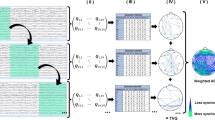Abstract
Recently proposed dynamic functional connectivity (dFC) approach, which focuses on the degree of spatial-temporal variability in regional-pair-wise functional connectivity (FC), is able to detect neural network alternations as the core neural basis of schizophrenia (SZ). Moreover, from the perspective of “emergence” in complex network science, the importance of the establishment of a method to evaluate the neural interactions in the whole brain network, not separating each pair-wise interaction, is emphasized. We proposed the micro-state approach based on the whole-brain instantaneous frequency distribution as one of these methods; this approach opens a new avenue as an evaluation method to detect cognitive function impairment and pathology. Thus, we hypothesized that the application of this micro-state approach to neural activity could detect the other aspects of brain network alterations for SZ previously elucidated in conventional FC and dFC. We applied the micro-state approach to electroencephalography (EEG) signals of SZ patients and healthy controls. The results revealed the alternation of dynamical leading phase transitions between the frontal and occipital regions and right and left hemispheric regions at the beta and gamma bands. This alternation suggested the corpus callosum impairments and abnormal enhancement of functional hub structure at the fast bands as topology of whole brain functional network. Thus, our proposed micro-state approach succeeded in detecting the state transition alternations concerning SZ pathology. This approach might contribute in elucidating new aspects of dFC, thereby resulting in the discovery of a biomarker for SZ.
Access this chapter
Tax calculation will be finalised at checkout
Purchases are for personal use only
Similar content being viewed by others
References
Green, M.F., Horan, W.P., Lee, J.: Nonsocial and social cognition in schizophrenia: current evidence and future directions. World Psychiatry 18(2), 146–161 (2019)
Correll, C.U., Schooler, N.R.: Negative symptoms in schizophrenia: a review and clinical guide for recognition, assessment, and treatment. Neuropsychiat. Dis. Treat. 16, 519 (2020)
Friston, K.J.: The disconnection hypothesis. Schizoph. Res. 30(2), 115–125 (1998)
Medaglia, J.D., Lynall, M.-E., Bassett, D.S.: Cognitive network neuroscience. J. Cogn. Neurosci.27(8), 1471–1491 (2015)
Cohen, J.R.: The behavioral and cognitive relevance of time-varying, dynamic changes in functional connectivity. NeuroImage 180, 515–525 (2018)
Takahashi, T., Goto, T., Nobukawa, S., Tanaka, Y., Kikuchi, M., Higashima, M., Wada, Y.: Abnormal functional connectivity of high-frequency rhythms in drug-naïve schizophrenia. Clin. Neurophysiol. 129(1), 222–231 (2018)
Sporns, O., Honey, C.J.: RolfKotter. Identification and classification of hubs in brain networks. PLoS ONE 2(10), e1049 (2007)
Misic, B., Vakorin, V.A., Paus, T., McIntosh, A.R.: Functional embedding predicts the variability of neural activity. Front. Syst. Neurosci. 5, 90 (2011)
Nobukawa, S., Kikuchi, M., Takahashi, T.: Changes in functional connectivity dynamics with aging: a dynamical phase synchronization approach. Neuroimage 188, 357–368 (2019)
Takahash, T., et al.: Antipsychotics reverse abnormal EEG complexity in drug-naive schizophrenia: a multiscale entropy analysis. Neuroimage 51(1), 173–182 (2010)
Fernández, A., Gómez, C., Hornero, R., José López-Ibor, J.: Complexity and schizophrenia. Progr. Neuro-Psychopharm. Biol. Psychiatr. 45, 267–276 (2013)
Dong, D., Duan, M., Wang, Y., Zhang, X., Jia, X., Li, Y., Xin, F., Yao, D., Luo, C.: Reconfiguration of dynamic functional connectivity in sensory and perceptual system in schizophrenia. Cereb. Cortex 29(8), 3577–3589 (2019)
Kang, J., Pae, C., Park, H.-J.: Graph-theoretical analysis for energy landscape reveals the organization of state transitions in the resting-state human cerebral cortex. PLoS ONE 14(9), e0222161 (2019)
Allen, E.A., et al.: Tracking whole-brain connectivity dynamics in the resting state. Cerebral Cortex 24(3), 663–676 (2014))
Tewarie, P., et al.: Tracking dynamic brain networks using high temporal resolution meg measures of functional connectivity. Neuroimage 200, 38–50 (2019)
Hu, M.L., et al.: A review of the functional and anatomical default mode network iMn schizophrenia. Neurosci. Bull. 33(1), 73–84 (2017)
Yin, W., et al.: The emergence of a functionally flexible brain during early infancy. Proc. Natl. Acad. Sci. 117(38), 23904–23913 (2020)
Sporns, O., Betzel, R.F.: Modular brain networks. Ann. Rev. Psychol. 67, 613–640 (2016)
Battiston, F., Cencetti, G., Iacopini, I., Latora, V., Lucas, M., Patania, A., Young, J.-G., Petri, G.: Networks beyond pairwise interactions: structure and dynamics. Phys. Rep. 874, 1–92 (2020)
Nobukawa, S., Ikeda, T., Kikuchi, M., Takahashi, T.: Dynamical characteristics of state transition defined by neural activity of phase in alzheimer’s disease. In: Mantoro, T., Lee, M., Ayu, M.A., Wong, K.W., Hidayanto, A.N. (eds.) ICONIP 2021. CCIS, vol. 1517, pp. 46–54. Springer, Cham (2021). https://doi.org/10.1007/978-3-030-92310-5_6
Khanna, A., Pascual-Leone, A., Michel, C.M., Farzan, F.: Microstates in resting-state EEG: current status and future directions: Neurosci. Biobeh. Rev. 49, 105–113 (2015)
Strelets, V., et al.: Chronic schizophrenics with positive symptomatology have shortened EEG microstate durations. Clin. Neurophysiol. 14, (11), 2043–2051 (2003)
Krukow, P., Jonak, K., Karpiński, R., Karakuła-Juchnowicz, H.: Abnormalities in hubs location and nodes centrality predict cognitive slowing and increased performance variability in first-episode schizophrenia patients. Sci. Rep. 9(1), 1–13 (2019)
van den Heuvel, M.P., Mandl, R.C.W. Stam, C.J., Kahn, R.S., Hulshoff Pol, H.E.: Aberrant frontal and temporal complex network structure in schizophrenia: a graph theoretical analysis. J. Neurosci. 30(47), 15915–15926 (2010)
Najjar, S., Pearlman, D.M.: Neuroinflammation and white matter pathology in schizophrenia: systematic review. Schizophrenia Res. 161(1), 102–112 (2015)
Jalili, M., Knyazeva, M.G.: EEG-based functional networks in schizophrenia. Comput. Biol. Med. 41(12), 1178–1186 (2011)
Acknowledgment
This study was supported by JSPS KAKENHI for a Grant-in-Aid for Scientific Research (C) (Grant No. 22K12183) (SN). This study was partially supported by the JST CREST (Grant No. JPMJCR17A4).
Author information
Authors and Affiliations
Corresponding author
Editor information
Editors and Affiliations
Rights and permissions
Copyright information
© 2023 The Author(s), under exclusive license to Springer Nature Switzerland AG
About this paper
Cite this paper
Ebina, D., Nobukawa, S., Ikeda, T., Kikuchi, M., Takahashi, T. (2023). Dynamic Characteristics of Micro-state Transition Defined by Instantaneous Frequency in the Electroencephalography of Schizophrenia Patients. In: Tanveer, M., Agarwal, S., Ozawa, S., Ekbal, A., Jatowt, A. (eds) Neural Information Processing. ICONIP 2022. Lecture Notes in Computer Science, vol 13624. Springer, Cham. https://doi.org/10.1007/978-3-031-30108-7_3
Download citation
DOI: https://doi.org/10.1007/978-3-031-30108-7_3
Published:
Publisher Name: Springer, Cham
Print ISBN: 978-3-031-30107-0
Online ISBN: 978-3-031-30108-7
eBook Packages: Computer ScienceComputer Science (R0)




